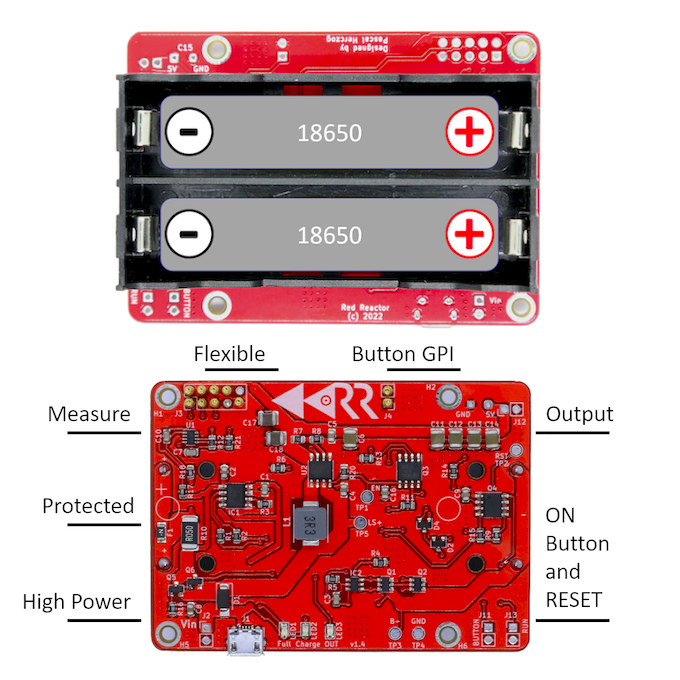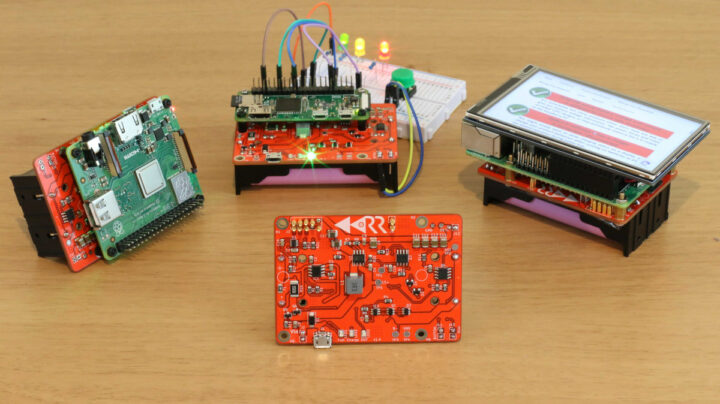Pascal Herczog’s Red Reactor is a battery power supply project that adds two 18650 batteries to Raspberry Pi 4, Raspberry Pi 3, or Raspberry Pi Zero board using the pogo pins for connection.
The pogo pin method means the Red Reactor is attached underneath the board, as such does not prevent the user to add a HAT expansion board on top of the single board computer. There’s also a headerless version for custom setup or compatibility with boards such as Arduino, Banana Pi, Orange Pi, etc… where some soldering is required.
Red Reactor’s key features and specifications:
- Battery holder for up to 2x flat-top 18650 LiPo batteries
- Battery voltage and current monitoring over I2C (INA219) for software safe shutdown control, system reset, and your own functions
- Safety
- Battery protection
- Resettable fuse protects against discharge between 2 cells
- Over-Charge, Over-Discharge, and 6A Over-Current protection
- Host connection
- Pogo pins for Raspberry Pi 4/3/Zero
- Headerless version where soldering is required
- Tested at up to 4A
- Misc
- LED’s for charging, charging complete, output ON, error conditions
- ON/OFF button connection
- Power input
- Soldered connection for high current usage
- 5V micro USB supply voltage
- Charging is limited to 1A to maximize battery life
- Seamless transition when external power is removed
- Power consumption – Less than 100uA in standby mode
- Dimensions
- 78.7 x 56 x 29mm (including stand-offs and battery holder)
- 4x mounting holes designed to fit Raspberry Pi Model A+/B+/2B/3A+/3B+ and Pi 4 boards, as well as compatible Banana Pi / Orange Pi designs
- 2x Mounting holes for Raspberry Pi Zero with 2 landing zones for additional supports
 You’ll need to install the INA219 Python3 package for battery monitoring
You’ll need to install the INA219 Python3 package for battery monitoring
|
1 |
sudo pip3 install pi-ina219 |
Pascal provides Python3 samples for battery monitoring either in the command line or through a web interface, and there’s also an LXDE GUI battery widget that will show up battery information, such as battery level, in the taskbar.

The Red Reactor board has launched on Kickstarter with a ~$10,000 funding target. Rewards start at $37 for the headerless version, and a $40 pledge is asked for the version with pogo pins. Shipping adds 4 GBP to the UK, about $11.40 to most European countries, and around $13.70 to the rest of the world. Backers should expect their perks to ship in January 2023 if everything goes according to plans. You’ll also need your own Raspberry Pi board and 18650 batteries for your project.
Via Hackster.io

Jean-Luc started CNX Software in 2010 as a part-time endeavor, before quitting his job as a software engineering manager, and starting to write daily news, and reviews full time later in 2011.
Support CNX Software! Donate via cryptocurrencies, become a Patron on Patreon, or purchase goods on Amazon or Aliexpress







The PiSugar uses a Lithium Ion battery instead of the 18650 cells, but otherwise has similar features. PiSugar is now in its 3rd generation and as worked well for my usage.
18650 is the dimensions and form of the li-ion cell, li-ion is the chemistry; both this thing and the PiSugar use li-ion, but PiSugar uses a pouch-cell.
“The Red Reactor board has launched on Kickstarter with a ~$10,000 funding target. Rewards start at $37 for the headerless version, and a $40 pledge is asked for the version with pogo pins. Shipping adds 4 GBP to the UK, about $11.40 to most European countries, and around $13.70 to the rest of the world.”
This looks like a copy of the “52Pi UPS V5 With RTC Battery Protection Management Module”. The 52Pi UPS boards have been around for awhile in ever evolving versions, it uses pogo pins too. The 52Pi is USD $29.09 each plus $1.35 shipping from China to United States (where I live) via AliExpress Standard Shipping (~2-4 weeks). I would need to closely compare the two boards to dig out the differences, however at first glance the 52Pi UPS has a HW RTC and the Red board does not. Also the Red board is a lot more expensive without the Kickstarter discount + delay (ships Jan. 2023) + risk + shipping to me in the U.S.
A meaningful comparison between the two boards requires schematics, but I cannot find one for either board. That is a deal-killer for me.
* The 52Pi UPS was briefly covered as part of this article:
https://www.cnx-software.com/2021/07/13/diy-raspberry-pi-4-mini-server-includes-ups-and-oled-information-display/
* 52Pi V5 UPS on AliExpress:
https://s.click.aliexpress.com/e/_DESo2Pl
* 52Pi UPS Wiki:
https://wiki.52pi.com/index.php?title=EP-0136